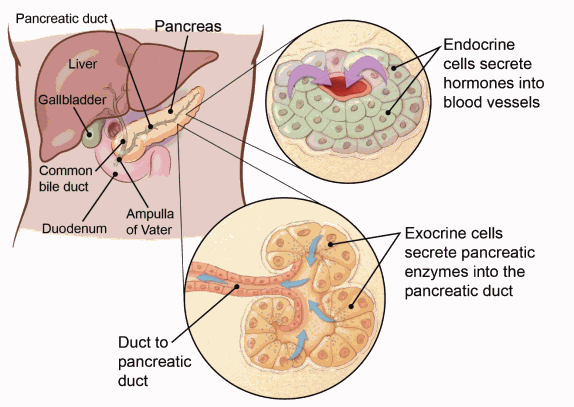Your gift is 100% tax deductible
What Is a Pancreatic Neuroendocrine Tumor?
Pancreatic neuroendocrine tumors (pNETs), or islet cell tumors, are a type of cancer that starts in the pancreas.
Pancreatic NETs are a less common type of pancreatic cancer. They are less than 2% of pancreatic cancers, but tend to have a better outlook (prognosis) than the more common type.
Where pancreatic neuroendocrine tumors start
Pancreatic neuroendocrine tumors start in neuroendocrine cells, a special cell found in the pancreas. Neuroendocrine cells are also found in other areas of the body, but only cancers that form from neuroendocrine cells in the pancreas are pancreatic neuroendocrine tumors.
The neuroendocrine system
Neuroendocrine cells are like nerve cells in some ways and like hormone-making endocrine cells in other ways. Cells in this system don't form actual organs. Instead, they are scattered throughout other organs like the esophagus, stomach, pancreas, intestines, and lungs.
Neuroendocrine cells (sometimes just called endocrine cells) in the pancreas are found in small clusters called islets (or islets of Langerhans). These islets make important hormones like insulin and glucagon (which help control blood sugar levels) and release them directly into the blood.
The pancreas
The pancreas is an organ that sits behind the stomach. In adults it's about 6 inches (15 centimeters) long but less than 2 inches (5 centimeters) wide.
- The head of the pancreas is on the right side of the abdomen (belly), behind where the stomach meets the duodenum, which is the first part of the small intestine).
- The body of the pancreas is behind the stomach.
- The tail of the pancreas is on the left side of the abdomen next to the spleen.

Neuroendocrine tumors start in the endocrine cells of the pancreas. These cells make hormones, such as insulin. Most of the pancreas is made up of another type of cell called exocrine cells. These cells form the exocrine glands and ducts. The exocrine glands make pancreatic enzymes that are released into the intestines to help you digest foods, especially fats. The most common type of pancreatic cancer, adenocarcinoma of the pancreas, starts from exocrine cells. See Pancreatic Cancer for more about this type.
If you are diagnosed with pancreatic cancer, it’s very important to know if it's an exocrine cancer or endocrine cancer (discussed here). They have distinct risk factors and causes, different signs and symptoms, are diagnosed with different tests, are treated in different ways, and have different outlooks.
Types of pancreatic neuroendocrine tumors, by grade
Pancreatic neuroendocrine tumors (pNETs) are classified by tumor grade, which describes how quickly the cancer is likely to grow and spread.
- Grade 1 (low-grade or well-differentiated) neuroendocrine tumors have cells that look more like normal cells and are not multiplying quickly.
- Grade 2 (intermediate-grade or moderately differentiated) tumors have features in between those of low- and high-grade (see below) tumors.
- Grade 3 (high-grade or poorly differentiated) neuroendocrine tumors have cells that look very abnormal and are multiplying faster.
Grade 1 or 2 pancreatic neuroendocrine tumors tend to grow slowly and can possibly spread to other parts of the body.
Cancers that are grade 3 are called pancreatic neuroendocrine carcinomas (pNECs). These cancers tend to grow and spread quickly and can spread to other parts of the body.
Another important part of grading is measuring how many of the cells are in the process of dividing into new cells. This is described in more detail in Pancreatic Neuroendocrine Tumor Stages.
Types of pancreatic neuroendocrine tumors, by function
Pancreatic neuroendocrine tumors are also named based on whether they make hormones that cause symptoms (functioning pNETs) or do not make hormones (non-functioning pNETs).
Functioning pNETs: About half of pNETs make hormones that are released into the blood and cause symptoms. Each one is named for the type of hormone the tumor cells make. Some tumors can make one or more of these hormones at the same time.
- Insulinomas come from cells that make insulin.
- Glucagonomas come from cells that make glucagon.
- Gastrinomas come from cells that make gastrin.
- Somatostatinomas come from cells that make somatostatin.
- VIPomas come from cells that make vasoactive intestinal peptide (VIP).
- ACTH-secreting tumors come from cells that make adrenocorticotropic hormone (ACTH).
- Serotonin-secreting tumors come from the cells that make serotonin. They are much more common in other parts of the digestive system, although rarely, they can start in the pancreas. These tumors are associated with carcinoid syndrome.
Most (up to 70%) functioning pNETs are insulinomas. The other types are much less common.
Non-functioning pNETs: These tumors don’t make enough excess hormones to cause symptoms. Because they don’t make excess hormones that cause symptoms, they can often grow quite large before they're found. Symptoms that may occur when they grow to a large size include abdominal pain, poor appetite, and weight loss.
The treatment and outlook for pNETs depend on the specific tumor type and the stage (extent) of the tumor, but the outlook is generally better than for pancreatic exocrine cancers.
- Written by
- References

Developed by the American Cancer Society medical and editorial content team with medical review and contribution by the American Society of Clinical Oncology (ASCO).
American Joint Committee on Cancer. Neuroendocrine Tumors of the Pancreas. In: AJCC Cancer Staging Manual. 8th ed. New York, NY: Springer; 2017.
National Cancer Institute. Physician Data Query (PDQ). Pancreatic Neuroendocrine Tumors (Islet Cell Tumors) Treatment – Patient Version. 2022. Accessed at https://www.cancer.gov/types/pancreatic/patient/pnet-treatment-pdq on March 20, 2025.
Schneider DF, Mazeh H, Lubner SJ, Jaume JC, Chen H. Chapter 71: Cancer of the endocrine system. In: Niederhuber JE, Armitage JO, Dorshow JH, Kastan MB, Tepper JE, eds. Abeloff’s Clinical Oncology. 5th ed. Philadelphia, Pa. Elsevier: 2014.
Last Revised: March 29, 2025
American Cancer Society medical information is copyrighted material. For reprint requests, please see our Content Usage Policy.
American Cancer Society Emails
Sign up to stay up-to-date with news, valuable information, and ways to get involved with the American Cancer Society.



